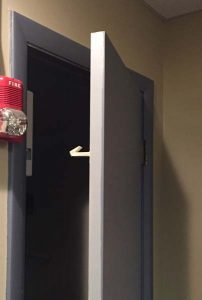Mind the Gap? Elevator Lock Recall Worth Minding
August 16th, 2016. By LucyC

Photo: CPSC.gov
Going Down?
No…wanted to go up actually. But who pays attention to those details, up, down, whatever—I usually get in for the ride before I realize the direction I’m going in—not a great metaphor for life but I digress.
To get to the point (good luck with that), there’s been an elevator recall. Don’t panic if you’re reading this on your way up to your office on the 35th floor. The recall involves residential elevators fitted with electro mechanical door locks. I believe the lingo is EMDLs. Guess what—they don’t work. The locks, not the elevators.
Apparently, the plastic locks can “allow” the landing door to open before the elevator car arrives, “posing a serious fall hazard to consumers attempting to board the elevator.” Allow? So locks can think now? What are the criteria upon which the locks make the decision to open—they don’t like the way you’re dressed? You or your progeny punched all the buttons on your last ride? Enquiring minds want to know.
Back to the recall, I believe the CPSC is attempting to warn people like myself who just move forward when the doors open, not paying attention to direction—as previously stated, or whether or not the elevator is even there. Details, right?
So to put this in context, you’ve pressed the button and now you’re back to your Pokemon Go thing when the outer door to the elevator opens. You are, quite reasonably, assuming that you’re going up to the 2nd floor, when in fact you are going to be taking a quick and potentially catastrophic slip and fall kind of move—without the elevator. All thanks to the EMDLs. (Wanted to use that).
The CPSC is advising, as a remedy, that “Consumers should immediately stop using elevators equipped with the electro mechanical door locks and contact their elevator service company to have the plastic locks replaced with metal parts.” Good advice. For those of us who read these things. I can’t help but wonder how they found out the locks weren’t working properly in the first place?
So far, Porta, the EMDLs manufacturer, has received two reports of lock failure. No injuries have been reported—remarkably. Or perhaps the bodies haven’t been discovered yet? Granny’s missing…but who would think to check the elevator shaft? On reflection, this does sort of have the makings of a Stephen King horror film. Remember “The Shining”?
And for your information, this is no minor recall—there’s 60,000 defective (or empowered, depending on how you want to interpret it) EMDLs out there.
Here’s the CPSC information: “This recall involves all residential elevators with plastic electro mechanical door locks. The EMDLs are installed as part of a complete residential elevator system. Locks included in this recall have a plastic generation 1, 2, 3 or 4 latch and keeper attached to the upper corner on the elevator side of each landing door. A UL or ETL label affixed to the bottom of the EMDL box has “Porta Inc.” printed on it.”
In case you have one of these EMDLs installed, the CPSC advises that “Consumers should contact their elevator service company. Consumers can also contact Porta Inc, toll-free at 844-719-9037 from 8 a.m. to 1 p.m. CT Monday through Thursday or online at www.emiporta.com and click on “Important Product Safety Notice” for more information. Consumers also can email the firm at .
They were sold through elevator manufacturers nationwide from January 2005 through December 2011 for between $20,000 and $40,000. Wow. Wonder what the fix is going to cost…
Better start paying attention—a good metaphor for life.
Archive by Category
- Accidents (24)
- Airlines (9)
- Asbestos Mesothelioma (262)
- Automotive (25)
- Celebrity (14)
- Class Action (84)
- Complaints/Comments (15)
- Consumer Fraud (84)
- Contest (2)
- Court of Public Opinion (5)
- Crazy Sh*t Lawyers See (61)
- Criminal Law (4)
- Defective Products (111)
- DePuy ASR Hip Recall (2)
- Discrimination (22)
- Drugs/Medical (248)
- Elder Care Abuse (4)
- Emerging Issues (462)
- Employment (54)
- Environment (52)
- Financial (28)
- Food Illness (15)
- Human/Civil Rights (4)
- Insecurities (5)
- Insurance (16)
- Intellectual Property (16)
- Internet/E-commerce (19)
- lawsuits (161)
- Lawyers (20)
- Lawyers Giving Back (43)
- Lex Levity (10)
- Personal Injury (106)
- Pleading Ignorance (53)
- Real Estate (2)
- Recall (6)
- Scam (3)
- Securities (13)
- Settlement (81)
- Tort Reform (2)
- Totally Tortelicious (81)
- Veterans (11)
- Whistleblower (9)
This is for just the USA or does it include Canada
apartment buildings & condos
The doors do not open automatically. The doors are hinged swing doors that look like every other door in the house. The lock keeper prevents the door from opening until the elevator arrives to activate the release. The hook of the lock is plastic and can be misaligned or become deformed, which allows anyone who can turn the doorknob to open the door without the elevator present.